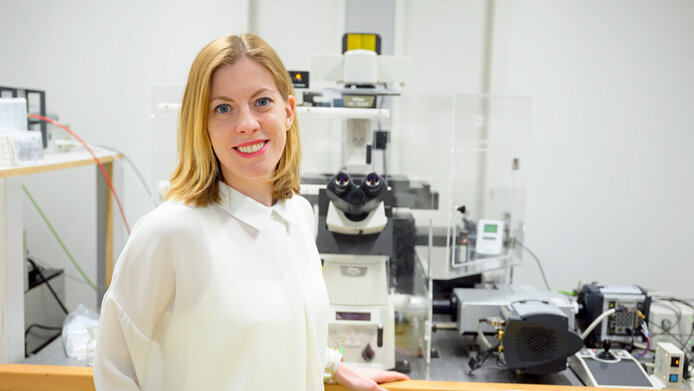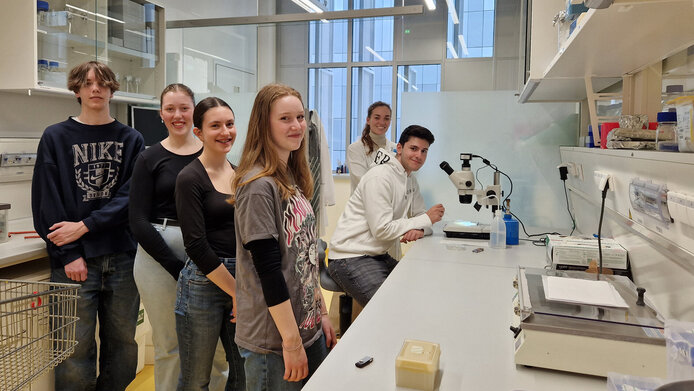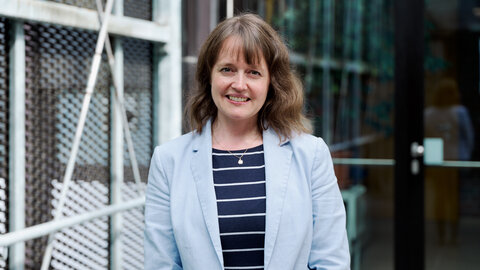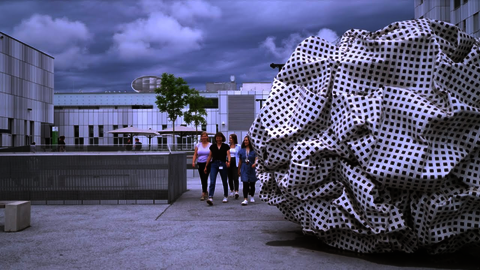Healthy aging

The World Health Organization expects the global number of people over 60 to double between 2015 and 2050. A higher life expectancy, however, goes hand in hand with conditions such as cancer and cardiovascular as well as neurodegenerative diseases. In Austria, the healthy life expectancy currently amounts to approximately 64 years. All over the globe, scientists are looking for factors that will allow us to extend this time span. But how much can an individual influence their own aging process? To a great extent, says age researcher Corina Madreiter-Sokolowski: “Seventy-five percent of how we age is determined by our lifestyle and environmental factors; our genes account for 25% of how this process pans out. That means there’s a lot we can do just by changing our lifestyle, even if we are at the mercy of our genes in some ways.”
Red grape
The molecular biologist is researching complex aging mechanisms and the life-extending potential of certain substances at the Medical University of Graz. Substances such as resveratrol or catechins have long been associated with positive effects on physical senescence. Resveratrol can, for example, be found in the skin of red grapes and thus also in red wine. This, however, should not be misunderstood as a recommendation to drink red wine, Madreiter-Sokolowski specifies: with the tiny doses of resveratrol contained in red wine, you’d drink yourself to an early grave trying to ingest the substance. Apart from red wine, it is also contained in blueberries, lingonberries, and cocoa. Does that mean it’s enough to down a handful of blueberries every day? Unfortunately, it’s not quite that simple. While studies have confirmed the life-prolonging effect of these active ingredients, the question is how much of them the body can absorb, i.e., how much actually makes it into the cells.
Personal details
Corina Madreiter-Sokolowski is an associate professor for “Molecular Aging” at the Medical University of Graz, where she currently heads a 13-person research group at the Gottfried Schatz Research Center for Cell Signaling, Metabolism and Aging.
How do substances get into cells?
This is exactly what the molecular biologist wants to find out. Her FWF-funded project zeroes in on substances that, on the one hand, can actually be absorbed by a person’s cells and, on the other hand, come in a dosage that the general population can tolerate, i.e., that can be easily ingested. Another research question she focuses on is when best to start taking these substances, already in middle age or starting at 60. All these questions have yet to be answered.
The wisdom of the nematode and what it means for us humans
Potentially life-expanding substances are first tested on cellular aging models and nematodes. The short life span of merely 30 days of this one-millimeter-long worm allows for a speedy active ingredient test and makes it the perfect model organism for age research. Its translucent body also lends itself to direct and meticulous observation of how the substances move through the organism and what effects they have on it, using fluorescence microscopy.
What we learn from the nematode, the expert states, tells us something about humans as well, as about 60 to 80% of its proteins also occur in our bodies. Through numerous experiments with cellular aging models and nematodes, the researcher has succeeded in pinpointing the effects of substances such as resveratrol or catechins on our cells, detailing how they slow down the aging process of the overall organism, improve our fitness, and thus increase longevity.
Why we age
Both substances modulate the mitochondrial metabolism, which powers our cells. Aging is basically an accumulation of so-called senescent cells. These cells more or less retire, i.e., they stop replicating. “This is, in fact, a way for the body to protect itself. If old cells replicated as quickly as young ones, mutations would occur more frequently and cause cancer,” Madreiter-Sokolowski explains. This protective mechanism, however, poses a different kind of problem: the retired cells release infection mediators that damage the environment of their cells. This is where substances such as resveratrol come in: “They overload the mitochondria of the old cells with calcium, which kills the cells. This prevents inflammatory processes originating in old cells,” the expert elucidates.
Fifteen years of drug development
Despite the promising results, it takes up to 15 years for a compound identified as an active substance in the lab to be approved as a drug. Many anti-aging substances are sold as supplements, which means that there are no promises regarding their effect. Contrary to that, the safety, efficiency, and also an effect that goes beyond the placebo effect must be confirmed for every medical substance through clinical studies, whose results are evaluated by the European Medicines Agency (EMA).
Long-winding paths to approved drugs
The path to an approved drug is long-winding and follows a cascading selection system: “All substances are first screened in cellular models, followed by model organisms such as nematodes, and only then tested on mice. Out of 5,000 substance candidates on which we conduct pre-clinical trials, only five will eventually be tested on humans. And out of those, only one will be approved,” Madreiter-Sokolowski describes the long road to selection. That’s why it’s so important to rely on good models that allow the scientists to clearly observe the mechanisms. It’s a question of both efficiency and safety. “There’s a lot that needs to be done in the run-up if we don’t want to lose our best candidate substances,” the expert says.
Calorie restriction
In the meantime, the researcher suggests sticking to tried-and-tested ways to slow down aging, for example through calorie restriction. According to the expert, cutting calorie intake by a mere 15% of the daily individual demand can in fact have a life-prolonging effect.
Positive effects on the organism
Already in the 1930s, scientists observed better health parameters in rats with reduced diets compared to other members of their species with unlimited food supply. Calorie reduction comes with a number of positive effects: “It decreases the body-mass index, blood pressure, cardiac risk markers, thyroid hormone levels, and the metabolism of the body’s cells. This saves our cells energy and enhances their life span, which in turn has positive effects on our overall organism,” the age researcher explains.
Longevity factor FOXO
The reasons behind all that were already deciphered back in the 1980s, following experiments with nematodes. Calorie restriction activates the FOXO3 transcription factor. An especially active form of this protein has also been found in centenarians. “FOXO3 is actually associated with longevity. Studies have shown that across so-called blue zones, the regions of the earth with the highest number of centenarians, people often follow a slightly calorie-reduced diet throughout their lives,” Madreiter-Sokolowski reports.
Fasting as a fountain of youth
Another health-promoting, scientifically proven method is intermittent fasting: scientists believe that fasting for about 14 to 16 hours on end induces a process called autophagy – a degradation of old cells – that helps the body dispose of damaged cells and cell parts. On the one hand, this saves resources, and on the other hand, it prevents old cells from accumulating and damaging surrounding young cells. The short-term effect of intermittent fasting has been scientifically proven. There is, however, no evidence of a long-term effect to date. “We don’t know if you need to fast this way on a regular basis, all life long, or if it’s enough to do it every few years,” Madreiter-Sokolowski concedes.
Strengthening the body’s defense system
There is scientific evidence of another major effect of calorie restriction and sports: both strengthen the body’s defense system against so-called oxygen radicals. Reactive oxygen species (ROS) can, for instance, be caused by smoking or UV radiation and can trigger so-called oxidative stress, which is linked to many diseases such as cancer or cardio-vascular conditions. “At the same time, we also need these oxygen radicals to trigger signaling pathways,” the biochemist lays out the basic dilemma. In another FWF-funded project, Madreiter-Sokolowski looks into how calcium can modulate the oxygen radicals in the mitochondria, thus strengthening the body’s defense system.
Thyroid hormones and cancer
A team of researchers also supports Madreiter-Sokolowski in studying age-related diseases such as cancer and, more specifically, how thyroid hormones change the calcium homeostasis in cancer cells, also financed by the FWF. “We already know that people who present with increased levels of thyroid hormones over a longer period of time are at greater risk of getting certain types of cancer,” the researcher explains.
From the piano to pharmacology ...
The passionate scientist, who is 34 years old, did not always know that she wanted to pursue a career in research. She grew up in the Pinzgau region in the Austrian province of Salzburg, in a small village along the Grossglockner High Alpine Road (“far flung from the world of science”), and originally planned to become a piano teacher. As a six-year-old, she discovered her love of the instrument and from then on spent hours on end practicing as a child and teenager. In high school, she commuted from Zell am See to the province capital of Salzburg to take piano lessons.
At some point, however, she found that she spent her commute reading biology books rather than musical theory. An avid endurance sports fan, she was also interested in the energy metabolism, which is why she chose the mitochondria as a topic for her pre-academic thesis. At 17, she decided to follow her passion and study cell biology – with a heavy heart and to the horror of her parents. “Nothing could be farther away from the reality in which I grew up than cell biology,” she recalls. She took her parents’ advice and enrolled in the pharmacology program, which would also allow her to work at a pharmacy. Today, she believes to have made the absolute right choice as she learned a lot about cell biology in her studies while also obtaining basic medical knowledge.
... and molecular biology
Following doctoral studies at the Medical University of Graz, she was a post-doc in Paris and Stockholm. Her two-year research stint at ETH Zurich, financed by the FWF through an Erwin Schrödinger Abroad Fellowship, laid the groundwork for her future career path: this was where she first did research on nematodes. During the return phase of the Erwin Schrödinger Fellowship, she was hired by the Medical University of Graz, where she successfully applied first for a tenure-track position and, in 2022, was appointed associate professor. At 34 years, she now already heads a 13-member research group and no less than four FWF-funded research projects. How does she do it?
Drive, opportunities and support
“I studied hard to graduate as quickly as possible and used every opportunity that came my way, I was surrounded by people who support me, and I was lucky to be in the right place at the right time,” the scientist recounts. A large portion of her success, of course, must be attributed to her drive, ambition, creativity, and maybe a tad of perfectionism.
Her advice for young female colleagues? Don’t plan too far ahead – things might work out completely differently than you thought. But do make sure to get all the qualifications you can, look for mentors, and create a supportive environment for yourself, also in your personal life. “You’ll need to find a partner who’s also passionate about something and understanding of your own ambition. That is often the biggest challenge,” she says. She was lucky enough to find a partner who supports her in all her endeavors. However, society is still lagging behind and he keeps finding he needs to apologize for doing so.
Young woman instead of old man
Apart from her own research, Madreiter-Sokolowski is also passionate about science communication. In the past two years, she has toured schools as a science ambassador on behalf of OeAD, Austria’s Agency for Education and Internationalisation, and experienced firsthand how her visit changed the image of science in the minds of the children. “The kids expect an old man and are suddenly confronted with a young woman. You can almost see the switch flipping. The ice is breaking, the kids are more open immediately, calling me by my first name,” she recounts. Many ask the researcher about her career path. The Salzburg-born scientist places special emphasis on being a role model for girls. That is why she focuses on visiting schools with a high share of female students. Promoting women remains an urgent topic for her. “At the universities, we still have the problem that many women leave after completing their doctoral studies, taking their excellent qualifications to jobs that actually pay less,” she says.
Young discoverers
In early June, the FWF-funded science communication project “Hands-on age research” for 14- to 16-year-old students took off at schools in the periphery. The adolescents get a chance to use the microscope and test active ingredients on nematodes. The goal is to connect with young people, make them aware of different career paths, and strengthen their trust in science. “All of our research will be futile if, in 20 years’ time, there won’t be any people around who trust our research and actually use what we’ve found out to their benefit,” the researcher underlines.
Basic research as a foundation
The freedom to pursue her own ideas is the scientist’s daily motivation. “University is like a big playing field that allows me to implement my own ideas day after day. It is pure luxury,” she smiles. At the same time, it is important to her to share with others what she is investigating and why it is so important. She is convinced that this is every scientist’s duty. “As researchers, it is our job to reach out to the people and communicate why chasing after some proteins is not just a bee in the bonnet of some lone scientists. The insights gained from basic research actively benefit us: they are what industrial research and, in our case, drug development are built on.”
Research focus aging
The research focus of molecular biologist Corina Madreiter-Sokolowski is on the role of mitochondria in our aging process and age-related diseases. For this purpose, she applies cutting-edge technologies such as high-resolution fluorescence microscopy both to cellular aging models and nematodes to identify potential approaches to developing new anti-aging strategies. The Austrian Science Fund (FWF) is funding three of her research projects as well as her science communication project “Hands-on age research”. Following a two-year, FWF-funded research stay at ETH Zurich, she was appointed assistant professor at the Medical University of Graz in 2020. In 2021, she received her venia docendi and in 2022, she was made an associate professor. She has won numerous awards with her research.







